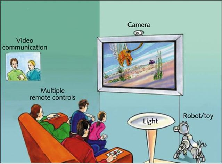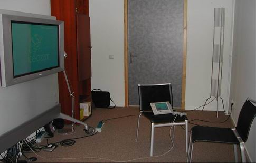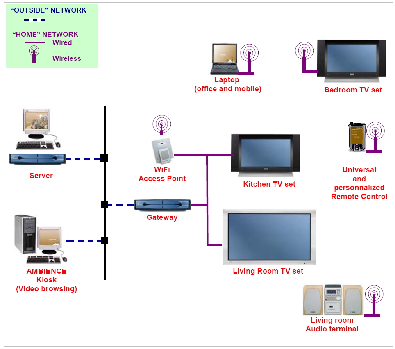Distributing Multimedia Elements to Multiple Networked Devices
(1) Philips Research The Netherlands
Prof. Holstlaan 4, 5656AA Eindhoven, The Netherlands
maddy.janse@philips.com
(2)
Department of Industrial Design
Den Dolech 2, 5600MB Eindhoven, The Netherlands
j.hu@tue.nl
2 Distributed displays for distributed video content
3 Distributed Displays for Follow-Me Video Content
4 Conclusion
Acknoledgements
References
1 Introduction
This position paper addresses the experiences from several projects that concern the presentation of video content on different distributed displays and connected objects in the home environment. The following cases will be considered: a) Distributed displays for distributed video content and b) Distributed displays for follow-me video content. Both cases are derived from applications that were developed in collaborative EU-funded projects, the ICE-CREAM [1] and Ozone [2] projects.
2 Distributed displays for distributed video content
The ICE-CREAM project investigated how to make compelling experiences for end-users based on the possibilities of integrating technologies for interactive media, for example, DVB-MHP, MPEG-4, 3D graphics and Internet technologies. Technological options that address different levels of interactivity for end-users were investigated and implemented in prototypes, and supported by business frameworks. In one of the applications a video is enhanced with fictional content, which uses 3D graphics and animations to enhance the users viewing experience. This application is a prototype of an interactive 3D movie about a deep-sea adventure in a submarine. Aside from the combination of video streams, 3D computer graphics, text, still pictures, soundtracks and multilingual interfaces, it also enhances the user’s experience by distributing the interactive content to multiple devices (lights, portable displays, robotic toys) to create ambience effects in the performance space - the end user’s environment. Characteristic features of this application are:
- Distributed interfaces, which enable cooperative interaction with the movie among multiple users. This assumes a social approach to content consumption.
- Synchronized lighting effects and robotic behaviors connecting the virtual 3D world to the reality. This assumes an immersive surrounding.
- Grabbing and storing of content elements for later reviewing by using a portable display. This extends the user’s experience to a broader time span than just during the movie.
- Wide range of interaction possibilities, such as customization of the journey, interaction with content elements, and full control of navigation, according to user skills, moods and interests.
This application was evaluated with end-users in a home environment setting (see Fig. 1). The evaluation was initially set up as a laboratory experiment for which variables could be clearly defined and controlled. Initiating an evaluation like this in the early development phases of an application in the interactive media domain especially in the home environment highlights several major research issues. First, the script and the content of the application were designed from the experience of production design for interactive shows. These shows aim at large audiences who will visit the show once and for whom the interaction is monitored by a show master. This is not the case for the home environment. Control and manipulation of variables during evaluation or adjustment after pilot tests is not possible in this situation. Maintaining a strict experimental design, however, makes it possible to generate valuable feedback in a structured way. Second, no existing measurement instruments address the appeal, the enjoyment and all the other factors that constitute a positive entertaining experience, especially for the specific case in which people can actually interact with the content itself in a distributed environment with multiple devices involved. We had to adapt, design, and develop the measurement instruments for the evaluation. Third, a prototype system in development in a research and design environment is hardly ever robust enough to endure normal user behavior. Iterations based on pilot test results are hardly possible due to high costs for content production and complexity of cooperation between the stakeholders in the value chain.
3 Distributed Displays for Follow-Me Video Content
The OZONE project implemented integrated embedded platform architecture for consumer oriented ambient intelligence applications that provide content and context relevant information and services to users anywhere and at anytime. The architecture consists of three layers: a top layer for service enabling applications; a middle layer responsible for seamless task migration, and a bottom layer for high performance computing at a low power level. One of the OZONE applications was based on using mobile terminals in an in-home network that consisted of partly wired Ethernet and 802.11b(see Fig. 2) . Users of this application could link video content from one terminal to another and move around while maintaining the visual presentation on different terminals.
The linking concept was implemented by connecting two or more receivers and to synchronize the same video content on the two devices. Proximity detection was used to initiate the receiving of video content by the second device. The linking concept was explained in scenarios in which several members of the same family want to watch the same video content on more receiving devices in more locations and at the same time. This linking concept was demonstrated and evaluated with users in a realistic home setting in the HomeLab of Philips Research.
The judgment of end-users with regard to perceived value, perception of image quality on the wireless receiver and to elicit input concerning viability, attractiveness and usefulness of wireless transmission of video was investigated. Image quality was identified as one of the most important factors for acceptance of the system. The linking concept was perceived as quite natural, but the review of the usage scenarios was rather skeptical. This implies that cost-effective solutions need to be found for investigating the usage in natural environments over longer periods of time and with more and richer combinations of wired and wireless connections with which users can experiment are needed.
The home networking system shares consumer electronics devices and PCs between users. The network has to deliver real-time audio and video to its users while network and device resources are shared. This implies that overload conditions may occur and that choices need to be made on the allocation of resources to the video streams and indirectly to the users of these streams. In the wireless part of the network fluctuations in bandwidth may occur due to overload and interference of other devices in the home. Optimal configurations for scalable video coding based on subjective judgments could solve this problem. Since a multitude of possible configurations is possible, user evaluations were conducted to provide initial baselines. Crucial here are the relationships between subjective acceptance of quality degradation and the optimal coding mechanism to apply.
Another promising source for decreasing resource demands that we investigated was the effective exploitation of shot changes. Handling multiple video streams within one terminal for more than one display constitutes another resource allocation problem. Balancing the trade-off between perceived and physical video quality for different size displays provides solutions for efficient resource allocation.
4 Conclusion
Applications for distributed display environments in the home were investigated. Evaluation of these applications revealed the following areas for promising new interaction research:
- Assessment methodologies that take the role of content into account and that operationalize multi-attribute concepts like fun and attractiveness;
- Interaction with content by users in the home environment;
- Distribution of ambiance effects in synchronization with or as a part of the content;
- Efficient configuring of scalable video and allocation of resources based on subjective quality evaluations.
- Methods for subjective video quality assessment in dynamic network environments.
Acknoledgements
The ICE-CREAM (IST-2000-28298) and OZONE (IST-2000-30026) projects are IST projects funded by the European Commission. We thank all the project partners who participated in the development and implementation of the applications.
References



